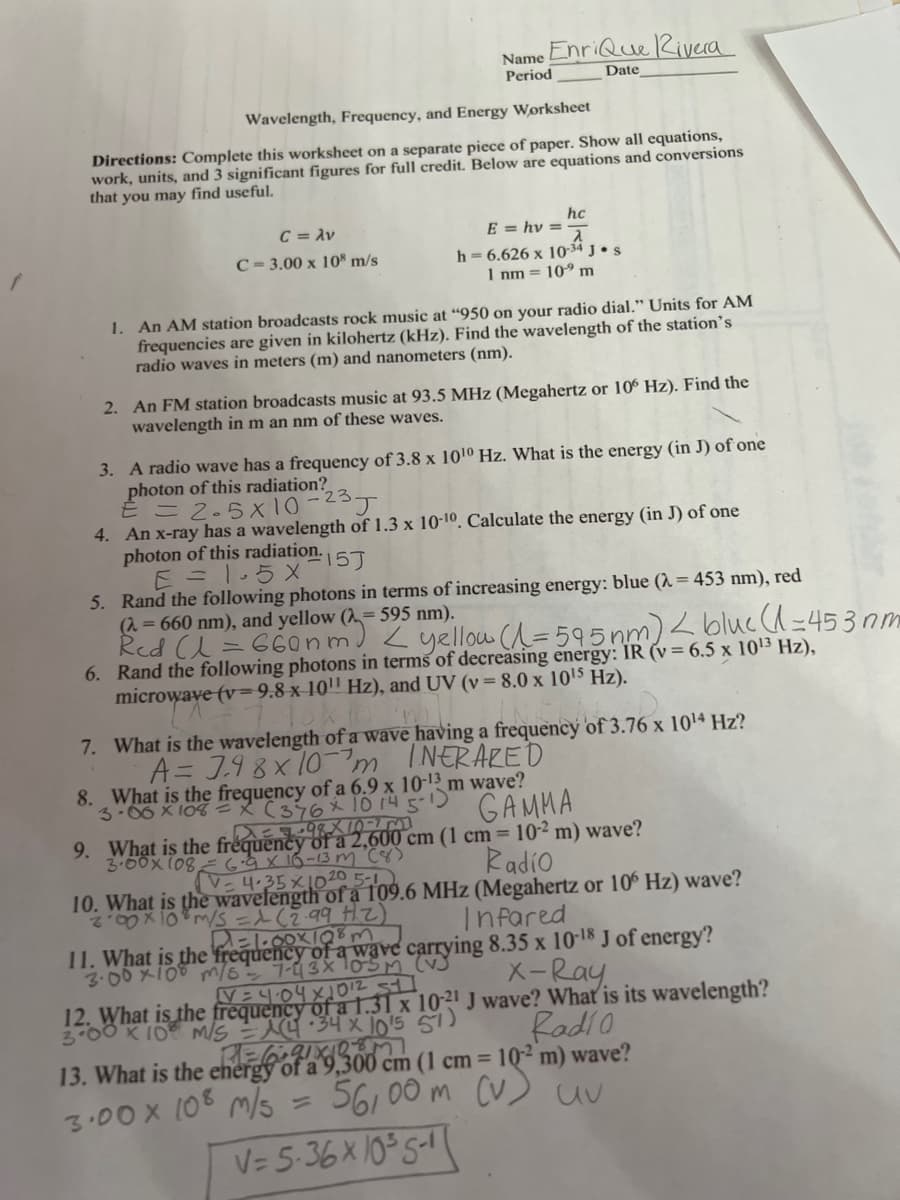1. An AM station broadcasts rock music at "950 on your radio dial." Units for AM frequencies are given in kilohertz (kHz). Find the wavelength of the station's radio waves in meters (m) and nanometers (nm). 2. An FM station broadcasts music at 93.5 MHz (Megahertz or 106 Hz). Find the wavelength in m an nm of these waves.
1. An AM station broadcasts rock music at "950 on your radio dial." Units for AM frequencies are given in kilohertz (kHz). Find the wavelength of the station's radio waves in meters (m) and nanometers (nm). 2. An FM station broadcasts music at 93.5 MHz (Megahertz or 106 Hz). Find the wavelength in m an nm of these waves.
Chemistry: The Molecular Science
5th Edition
ISBN:9781285199047
Author:John W. Moore, Conrad L. Stanitski
Publisher:John W. Moore, Conrad L. Stanitski
Chapter5: Electron Configurations And The Periodic Table
Section: Chapter Questions
Problem 5.ACP
Related questions
Concept explainers
Atomic Structure
The basic structure of an atom is defined as the component-level of atomic structure of an atom. Precisely speaking an atom consists of three major subatomic particles which are protons, neutrons, and electrons. Many theories have been stated for explaining the structure of an atom.
Shape of the D Orbital
Shapes of orbitals are an approximate representation of boundaries in space for finding electrons occupied in that respective orbital. D orbitals are known to have a clover leaf shape or dumbbell inside where electrons can be found.
Question
100%
Hi sorry to bother I know the limit of questions is 3 so could you please provide the answers for 1,2, 6 please thank you

Transcribed Image Text:Name Enrique Rivera
Period
Date
Wavelength, Frequency, and Energy Worksheet
Directions: Complete this worksheet on a separate piece of paper. Show all equations,
work, units, and 3 significant figures for full credit. Below are equations and conversions
that you may find useful.
hc
C = λν
E = hv==
C-3.00 x 108 m/s
h-6.626 x 10-34 J. s
1 nm = 10⁹ m
1. An AM station broadcasts rock music at "950 on your radio dial." Units for AM
frequencies are given in kilohertz (kHz). Find the wavelength of the station's
radio waves in meters (m) and nanometers (nm).
2. An FM station broadcasts music at 93.5 MHz (Megahertz or 106 Hz). Find the
wavelength in m an nm of these waves.
3. A radio wave has a frequency of 3.8 x 10¹0 Hz. What is the energy (in J) of one
photon of this radiation?
€ = 2.5x10-23J
4. An x-ray has a wavelength of 1.3 x 10-10. Calculate the energy (in J) of one
photon of this radiation.
15J
E = 1.5 X
5. Rand the following photons in terms of increasing energy: blue (λ = 453 nm), red
(λ = 660 nm), and yellow (= 595 nm).
Red (1 = 660nm) < yellow (1=595 nm) < blue (1=453 nm
6. Rand the following photons in terms of decreasing energy: IR (v = 6.5 x 10¹³ Hz),
microwave (v=9.8 x 10¹¹ Hz), and UV (v = 8.0 x 10¹5 Hz).
'n
7. What is the wavelength of a wave having a frequency of 3.76 x 10¹4 Hz?
A = 7.98 x 10-7m
INERARED
8. What is the frequency of a 6.9 x 10-13 m wave?
3-06 x 108X (376x 10 14 5-1)
GAMMA
X == -98X1073
9. What is the frequency of a 2,600 cm (1 cm = 10-² m) wave?
3.00x 108
G.9 X 16-13m
(8)
4.35 × 10 20 5-1
Radio
10. What is the wavelength of a 109.6 MHz (Megahertz or 106 Hz) wave?
200 x 10 m/s = 1 (2.99 Hz)
d=1.00×108m
Infared
11. What is the frequency of a wave carrying 8.35 x 10-18 J of energy?
X-Ray
V=4.04×1012 311
12. What is the frequency of a 1.31 x 10-21 J wave? What is its wavelength?
3.00 x 10 M/S = A(4·34 x 10¹5 57)
Radio
13. What is the energy
3.00 x 108 m/s
BEOT 3
cm (1 cm = 10-2 m) wave?
56,00 m (v) uv
V=5.36x10³5-1
Expert Solution
This question has been solved!
Explore an expertly crafted, step-by-step solution for a thorough understanding of key concepts.
This is a popular solution!
Trending now
This is a popular solution!
Step by step
Solved in 2 steps with 2 images

Knowledge Booster
Learn more about
Need a deep-dive on the concept behind this application? Look no further. Learn more about this topic, chemistry and related others by exploring similar questions and additional content below.Recommended textbooks for you

Chemistry: The Molecular Science
Chemistry
ISBN:
9781285199047
Author:
John W. Moore, Conrad L. Stanitski
Publisher:
Cengage Learning

Principles of Modern Chemistry
Chemistry
ISBN:
9781305079113
Author:
David W. Oxtoby, H. Pat Gillis, Laurie J. Butler
Publisher:
Cengage Learning

Chemistry & Chemical Reactivity
Chemistry
ISBN:
9781133949640
Author:
John C. Kotz, Paul M. Treichel, John Townsend, David Treichel
Publisher:
Cengage Learning

Chemistry: The Molecular Science
Chemistry
ISBN:
9781285199047
Author:
John W. Moore, Conrad L. Stanitski
Publisher:
Cengage Learning

Principles of Modern Chemistry
Chemistry
ISBN:
9781305079113
Author:
David W. Oxtoby, H. Pat Gillis, Laurie J. Butler
Publisher:
Cengage Learning

Chemistry & Chemical Reactivity
Chemistry
ISBN:
9781133949640
Author:
John C. Kotz, Paul M. Treichel, John Townsend, David Treichel
Publisher:
Cengage Learning

Chemistry & Chemical Reactivity
Chemistry
ISBN:
9781337399074
Author:
John C. Kotz, Paul M. Treichel, John Townsend, David Treichel
Publisher:
Cengage Learning

Principles of Instrumental Analysis
Chemistry
ISBN:
9781305577213
Author:
Douglas A. Skoog, F. James Holler, Stanley R. Crouch
Publisher:
Cengage Learning

Chemistry: Principles and Practice
Chemistry
ISBN:
9780534420123
Author:
Daniel L. Reger, Scott R. Goode, David W. Ball, Edward Mercer
Publisher:
Cengage Learning